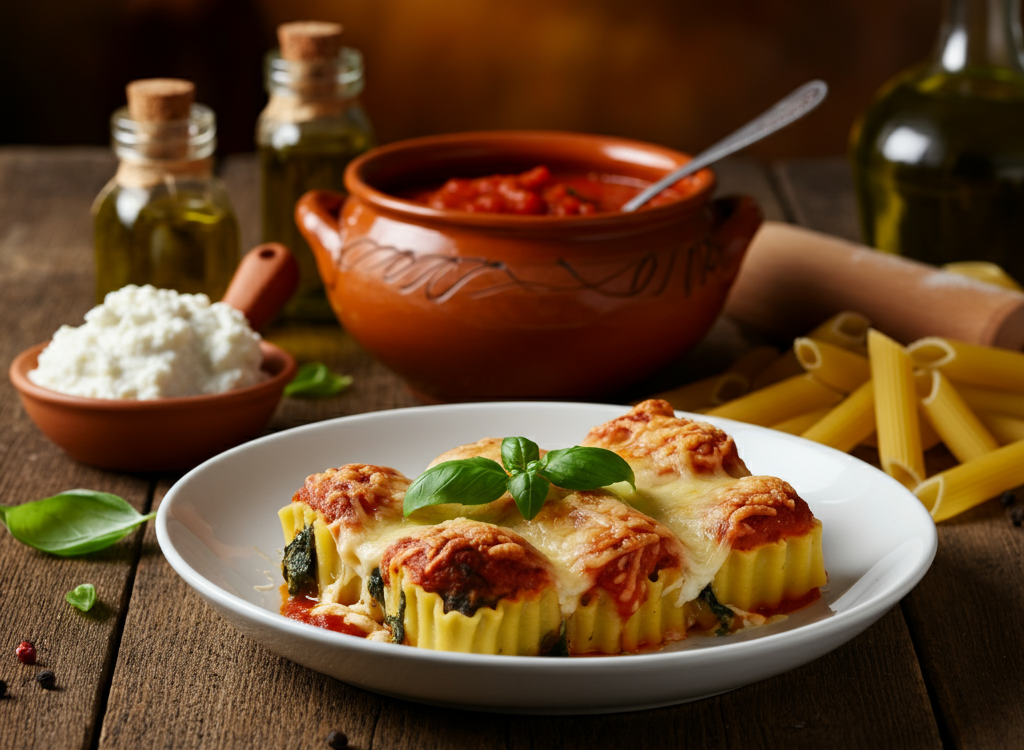There’s something deeply nostalgic about mannacote—the kind of dish that transports you straight into an Italian kitchen, alive with laughter and the aroma of baking cheese. Mannacote isn’t just food; it’s warmth and connection, the centerpiece of family gatherings, holiday feasts, and quiet Sunday dinners alike. With its luxuriously cheesy filling and hearty tomato sauce, this Italian comfort food has earned a devoted following both in Italy and abroad.
Drawing on years of hands-on cooking, interviews with Italian home cooks, and research into regional Italian cuisine, this comprehensive guide explores everything you need to know about mannacote—from its fascinating origins and culinary significance to home-cook-tested tips and innovative variations. Dive in, and let’s make your kitchen the heart of your home.
The Origins and Culinary Significance of Mannacote
Mannacote—sometimes found as manicotti—derives its name from the Italian
manicotto, meaning “little sleeve.” This is a culinary nod to the large, tube-shaped pasta that’s stuffed with decadent cheese fillings, then baked to bubbly perfection. The true roots of mannacote trace back to country kitchens in southern Italy, where resourceful cooks made the most of humble ingredients. Cheese, eggs, and home-milled flour became the foundation for filling and fortifying meals, especially during chilly seasons.
As Italian immigrants brought these traditions to America, mannacote adapted joyfully. The dish evolved to include vibrant tomato sauces, generous layers of mozzarella cheese, and ever more inventive fillings—melding Old World comfort with New World bounty. Today, mannacote remains a beloved staple on both sides of the Atlantic, often served at family celebrations and special occasions. Its enduring popularity stands as a testament to the universal power of food to bring people together.
How to Make Mannacote Like an Italian Nonna
If you’re after that restaurant-quality taste at home, a few simple techniques and the right ingredients make all the difference. Take a cue from Italian chefs—focus on quality over quantity and put care into every layer.
Essential Ingredients for Mannacote
- For the Pasta:
- 12 dried mannacote or manicotti pasta tubes
- Olive oil for greasing the baking dish and pasta
- For the Filling:
- 2 cups whole-milk ricotta cheese
- 1½ cups shredded mozzarella cheese (plus ¾ cup for topping)
- ½ cup freshly grated Parmesan cheese
- 1 large egg (beaten)
- 2 tablespoons finely chopped fresh basil (or 1 tablespoon dried basil)
- 1 teaspoon sea salt
- ½ teaspoon black pepper
- For the Sauce:
- 3 cups quality marinara sauce (homemade or store-bought)
- ¼ teaspoon red pepper flakes (optional)
Equipment You’ll Need: A large pot, a 9×13-inch baking dish, a sturdy mixing bowl, a piping bag (or a resealable plastic bag with a corner cut off), and aluminum foil.
Step-By-Step Cooking Instructions for Mannacote
1. Cook the Pasta
Bring a generous pot of salted water to a boil, and add the mannacote tubes. Cook for no more than 6–7 minutes; you want them
al dente so they remain sturdy during stuffing. Rinse under cold water and toss lightly with olive oil.
2. Prepare the Filling
Mix ricotta, 1½ cups mozzarella, Parmesan, egg, basil, salt, and pepper in a large bowl. Aim for a creamy, just-stirred texture—don’t overmix, or it’ll get dense.
3. Stuff the Pasta Tubes
Transfer the cheese mixture to your piping bag. Pipe the filling into each mannacote tube gently, filling both ends. Lay the stuffed tubes side by side in a lightly greased baking dish.
4. Assemble and Layer
Pour about 1 cup of marinara sauce across the bottom. Line up the filled mannacote tubes, then cover with the remaining sauce. Sprinkle the rest of the mozzarella on top.
5. Bake to Perfection
Preheat your oven to 375°F (190°C). Cover your dish with foil and bake for 25 minutes, then uncover and bake another 15–20 minutes, until the cheese is golden and bubbling. Allow your mannacote to rest 10 minutes before serving—this step helps it hold together beautifully when sliced.
Expert Tips from the Pros
- Let ricotta come to room temperature for a smoother filling.
- Undercook pasta slightly to prevent tearing during stuffing.
- Select a rich, low-sugar tomato sauce for depth.
- Add chopped spinach or sautéed mushrooms for extra flavor and nutrients.
- If you’re new to stuffing pasta, don’t stress over a little mess; practice makes perfect.
Mannacote Recipes for Every Diet and Preference
Whether you follow a gluten-free, vegan, or meat-lover’s lifestyle, there’s a mannacote version for you. Impress your guests or please picky eaters—these adaptations have you covered.
Gluten-Free Mannacote
Choose certified gluten-free mannacote tubes. Alternatively, thinly slice zucchini or eggplant lengthwise, blanch, and use them as “shells.” They bake up tender and don’t overpower the cheese filling.
Vegan Mannacote
- For the ricotta, make your own by blending firm tofu with lemon juice, nutritional yeast, garlic, and a bit of olive oil.
- Use plant-based mozzarella and Parmesan alternatives.
- Pick a dairy-free marinara sauce for the best flavor.
Seafood Mannacote
Try adding gently cooked shrimp, crab, or scallops to the cheese mixture. For an upscale twist, swap the red sauce for a basic homemade béchamel, or brighten your dish with a hit of lemon zest.
Spicy Meat-Lover’s Mannacote
Crumble cooked Italian sausage or seasoned ground beef into the filling. Toss red pepper flakes into the sauce if you crave more heat.
Low-Carb Mannacote
Skip traditional pasta tubes and use pliable cabbage leaves or large portobello mushrooms as a base for the cheese stuffing. They bake up rich and savory with fewer carbs.
Frequently Asked Questions About Mannacote
Can I substitute cottage cheese for ricotta?
Absolutely! Just make sure to use full-fat, small-curd cottage cheese and blend it for a smooth consistency. Many Italian-American families use this swap for a lighter flavor.
How do I store mannacote leftovers?
Let the dish cool completely and store individual servings in an airtight container in the fridge (up to 3 days). Reheat gently in a 350°F oven or microwave—just cover with foil to keep it from drying out.
Can I freeze unbaked mannacote?
Yes! After assembling the dish, cover tightly with foil and freeze for up to 3 months. Bake from frozen, adding 15–20 minutes to your usual time.
How do I keep the pasta tubes from ripping while stuffing?
Stop cooking before they get truly soft, and make sure the pasta is completely cool and very dry before stuffing. Using a piping bag is also much gentler on the tubes than a spoon.
What side dishes go well with mannacote?
Classic pairings include a Caesar salad, tangy vinaigrette-dressed greens, roasted asparagus, and—if you want to go all out—warm garlic bread. For wine, you can’t go wrong with an Italian red such as Chianti or Montepulciano.
Bringing Mannacote Into Your Kitchen—Final Thoughts
Mannacote is more than a recipe—it’s a time-honored tradition, a deeply flavorful bite of both Italy and home. Whether you’re tapping into an old family recipe or cooking it up for the first time, the joy comes not just from the food, but from the moments you’ll share. The approachable, comforting layers of this dish make it a favorite for casual weeknights and festive occasions alike.
If this mannacote guide helps you create a meal to remember, let us know! Drop your thoughts or tweaks in the comments, or tag your kitchen photos with
#MannacoteMagic—we can’t wait to see your take on a classic Italian comfort food. Buon appetito!



